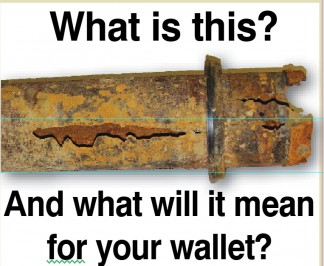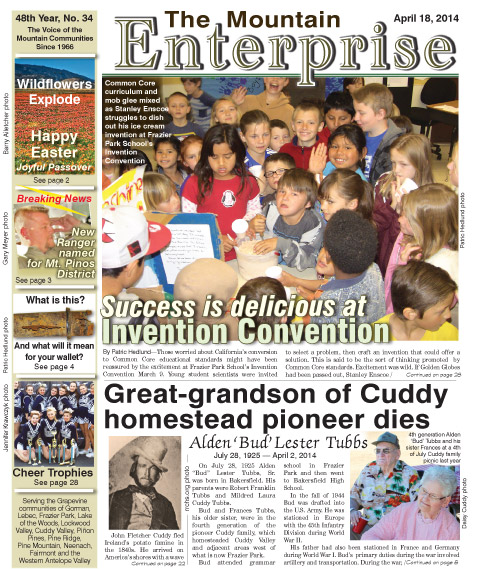
The corroded steel pipes from Frazier Park Public Utility District's distribution system have been partially replaced, but the work must continue to remove the 1926-era infrastructure in Frazier Park's neighborhoods. Leaking causes loss of revenue, and rust nodules enter water meters and block their ability to measure water use accurately, consultant Rob Shirley reported.
By Patric Hedlund
Operating losses from 2011 and 2012 totalled $287,000 at the Frazier Park Public Utility District according to charts shown this week. The public was invited to hear the report by independent consultant Rob Shirley on Thursday, April 17. A preview of the report was given on April 14.
What caused the loss? The abrupt halt in construction nationwide following the financial crisis of 2008 hit Frazier Park too. Fees for new water hook-ups stopped dead by 2010. By 2011, foreclosures dropped the number of actual customers connected on the system to about 1,295 homes in the district.
The large number of vacant homes and vacation cabins with water service turned off also lowered
revenues for the water company.
Back in 2005, FPPUD’s board began a much-needed five-phase renovation of the system that was originally built starting in 1926 (in some places with redwood pipes, according to Field Operations Manager Jonnie Allison).
Phase One replaced the system’s legacy water tanks before they could spring major leaks. Phase Two replaced many of the main pipes in Frazier Park.
But the pipes distributing water within Frazier Park’s neighborhoods [such as the pipe pictured at left] still need to be replaced. Federal grants of $2 million, along with low-interest USDA loans, have so far financed the work, Director Lisa Schoenberg said, but more needs to be done. Meanwhile, repayment of the low-interest federal loans has begun. A capital reserve fund for replacement and repairs—used to sustain FPPUD through the losses—needs to be replenished, Shirley said.
The consultant proposed a base rate increase plus a tiered rate structure for consumption that encourages conservation. The combined increases would average between $9.69 to $11.58 for most residences, but more for larger users. Letters about the rate change process are in the mail to customers this week also.
Despite challenges, FPPUD has managed very well compared to many other small systems in California, Shirley said.
Photo captions:
This sample 6-inch pipe was pulled out of a neighborhood distribution line in Frazier Park. Corrosive action of local soils on old steel pipes thins the walls of the pipes, causing leaks and water loss (resulting in lost revenue) and accelerates the need to replace infrastructure. Rust nodules shed from the inside of the pipes are carried into meter mechanisms, causing inaccurate metering (resulting in more lost revenue).
Field Operations Manager Jonnie Allison shows the device FPPUD uses to test water meters. Many have been damaged by particles from corroding pipes.
FPPUD’s outside consultant Rob Shirley
To see full stories with photos, please go to The Mountain Enterprise e-Edition
(login required)
Have your newspaper delivered via mail and include internet access! Just call 661-245-3794.
Or step out and get it right now! This story and others are available right now at newsstands throughout the Mountain Communities in The Mountain Enterprise.
This is part of the April 18, 2014 online edition of The Mountain Enterprise.
Have an opinion on this matter? We'd like to hear from you.


